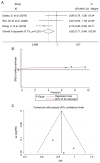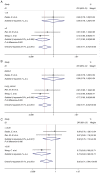Association between long non-coding RNA HOTAIR polymorphism and lung cancer risk: A systematic review and meta-analysis
- PMID: 35837044
- PMCID: PMC9257968
- DOI: 10.3892/etm.2022.11477
Association between long non-coding RNA HOTAIR polymorphism and lung cancer risk: A systematic review and meta-analysis
Abstract
Single nucleotide polymorphism (SNP) of long noncoding RNA (lnc)RNA has been reported to be an important factor in cancer development. Recently, lncRNA homeobox transcript antisense intergenic RNA (HOTAIR) was indicated to induce tumorigenesis of several cancer types, but the association between the SNP of lncRNA HOTAIR and lung cancer susceptibility has remained undetermined. The present meta-analysis aimed to investigate the effect of HOTAIR polymorphism on susceptibility to lung cancer. The PubMed, Ovid Medline, Embase and Cochrane Library databases were thoroughly searched. Studies containing data on the incidence of lung cancer in patients with different HOTAIR SNPs were included. The Hardy-Weinberg equilibrium was analyzed to determine genotype distribution and allele frequencies. The odds ratio (OR) was pooled to evaluate the association of different SNPs with the susceptibility to lung cancer. A total of six studies comprising 1,715 patients with lung cancer and 2,745 healthy controls were finally included. A total of 4 SNPs (rs12826786, rs1899663, rs920778 and rs4759314) were reported. Analyses for all of these SNPs individually indicated that the lncRNA HOTAIR rs1899663 C>A polymorphism was a risk factor for lung cancer (dominant mode, AA+CA vs. CC: OR=0.816, 95% CI=0.707-0.942, P=0.005). The present study was the first meta-analysis investigating the association between lncRNA HOTAIR and lung cancer susceptibility. The results indicated that the lncRNA HOTAIR rs1899663 C>A polymorphism is a risk factor for lung cancer. LncRNA HOTAIR may be of value in lung cancer screening, particularly for populations with high-risk factors, as well as prognosis prediction. Future investigations are required to further clarify the intrinsic mechanism of the role of HOTAIR in the oncogenesis of lung cancer.
Keywords: HOTAIR; SNP; lncRNA; lung cancer; susceptibility.
Copyright: © Ke et al.
Conflict of interest statement
The authors declare that they have no competing interests.
Figures




Similar articles
-
The effect of long noncoding RNAs HOX transcript antisense intergenic RNA single-nucleotide polymorphisms on breast cancer, cervical cancer, and ovarian cancer susceptibility: A meta-analysis.J Cell Biochem. 2019 May;120(5):7056-7067. doi: 10.1002/jcb.27975. Epub 2018 Nov 28. J Cell Biochem. 2019. PMID: 30484890
-
HOTAIR lncRNA SNPs rs920778 and rs1899663 are associated with smoking, male gender, and squamous cell carcinoma in a Chinese lung cancer population.Acta Pharmacol Sin. 2018 Nov;39(11):1797-1803. doi: 10.1038/s41401-018-0083-x. Epub 2018 Aug 28. Acta Pharmacol Sin. 2018. PMID: 30154526 Free PMC article.
-
Roles of HOTAIR in lung cancer susceptibility and prognosis.Mol Genet Genomic Med. 2020 Jul;8(7):e1299. doi: 10.1002/mgg3.1299. Epub 2020 May 11. Mol Genet Genomic Med. 2020. PMID: 32394637 Free PMC article.
-
A systematic review and meta-analysis of the association between HOTAIR polymorphisms and susceptibility to breast cancer.Arch Med Sci. 2019 Aug 27;19(1):128-137. doi: 10.5114/aoms.2019.87537. eCollection 2023. Arch Med Sci. 2019. PMID: 36817654 Free PMC article. Review.
-
Genetic association between HOTAIR gene and the risk of cancer: an updated meta-analysis.J Genet. 2020;99:48. J Genet. 2020. PMID: 32661201 Review.
Cited by
-
Role of rs2366152 single-nucleotide variant located in the long noncoding RNA HOTAIR gene in the cervical cancer susceptibility in a Polish population.J Appl Genet. 2024 Sep;65(3):511-518. doi: 10.1007/s13353-023-00822-3. Epub 2023 Dec 29. J Appl Genet. 2024. PMID: 38157198 Free PMC article.
-
HOTAIR as a diagnostic and prognostic biomarker of gastrointestinal cancers: an updated meta-analysis and bioinformatics analysis based on TCGA data.Biosci Rep. 2023 Mar 31;43(3):BSR20222174. doi: 10.1042/BSR20222174. Biosci Rep. 2023. PMID: 36924407 Free PMC article.
-
LncRNAs has been identified as regulators of Myeloid-derived suppressor cells in lung cancer.Front Immunol. 2023 Feb 2;14:1067520. doi: 10.3389/fimmu.2023.1067520. eCollection 2023. Front Immunol. 2023. PMID: 36817434 Free PMC article. Review.
-
HOTAIR in cancer: diagnostic, prognostic, and therapeutic perspectives.Cancer Cell Int. 2024 Dec 19;24(1):415. doi: 10.1186/s12935-024-03612-x. Cancer Cell Int. 2024. PMID: 39702144 Free PMC article. Review.
-
The Regulatory Role of LncRNAs in Modulating Autophagy and Drug Resistance in Non-Small-Cell Lung Cancer: Focus on Targeted Therapeutic Approaches.Biomolecules. 2025 Jul 5;15(7):968. doi: 10.3390/biom15070968. Biomolecules. 2025. PMID: 40723840 Free PMC article. Review.
References
LinkOut - more resources
Full Text Sources
Research Materials
